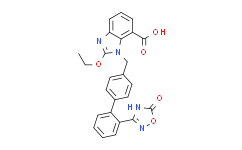| Cas No.: | 147403-03-0 |
| Chemical Name: | Azilsartan free acid |
| Synonyms: | Azilsartan;2-Ethoxy-1-[[2'-(4,5-dihydro-5-oxo-1,2,4-oxadiazol-3-yl)biphenyl-4-yl]methyl]benzimidazole-7-carboxylic acid;Tak 536;Unii-F9nux55p23;2-ethoxy-3-((2'-(5-oxo-2,5-dihydro-1,2,4-oxadiazol-3-yl)biphenyl-4-yl)Methyl)-3H-benzo[d]iMidazole-4-carboxylic acid;Azilsartan 2-Ethoxy-1-[[2'-(4,5-dihydro-5-oxo-1,2,4-oxadiazol-3-yl)biphenyl-4-yl]Methyl]benziMidazole-7-carboxylic acid;1-[[2'-(2,5-Dihydro-5-oxo-1,2,4-oxadiazol-3-yl)[1,1'-biphenyl]-4-yl]Methyl]-2-ethoxy-1H-benziMidazole-7-carboxylic Acid;Azilsartan (TAK-536);2-ethoxy-3-[[4-[2-(5-oxo-2H-1,2,4-oxadiazol-3-yl)phenyl]phenyl]methyl]benzimidazole-4-carboxylic acid;zilsartan;1H-Benzimidazole-7-carboxylic acid,1-[[2'-(2,5-dihydro-5-oxo-1,2,4-oxadiazol-3-yl)[1,1'-biphenyl]-4-yl]methyl]-2-ethoxy;TAK-536;AZILSARTAN;AZATMint-E;Azilsartan API;Azilsartan metabolite MI D4;Azilsartan metabolite MII-D4;AzilsartanMedoxoMilInterMediates-3 |
| SMILES: | CCOC1=NC2=CC=CC(C(=O)O)=C2N1CC1=CC=C(C2=CC=CC=C2C2=NOC(=O)N2)C=C1 |
| Formula: | C25H20N4O5 |
| M.Wt: | 456.46 |
| Purity: | >99% |
| Sotrage: | 2 years -20°C Powder, 2 weeks 4°C in DMSO, 6 months -80°C in DMSO |
| Description: | Azilsartan(TAK-536) is a specific and potent angiotensin II type 1 receptor antagonist with IC50 of 2.6 nM. |
| Target: | AT1 receptor IC50 Value: 2.6 nM [1] |
| In Vivo: | In 4 randomized controlled trials (3 published to date), azilsartan medoxomil/chlorthalidone 40 mg/12.5 mg and 40 mg/25 mg reduced blood pressure (BP) significantly more than comparators did, including an approximately 5-mm Hg greater BP reduction than olmesartan medoxomil/hydrochlorothiazide 40 mg/25 mg and azilsartanmedoxomil/hydrochlorothiazide [3]. Both TAK-536 and candesartan suppressed the increase in plasma glucose level in the OGTT without significant change in insulin concentration and improved insulin sensitivity. In adipose tissue, TAK-536 and candesartan reduced TNF-alpha expression but increased the expression of adiponectin, PPARgamma, C/EBalpha, and aP2 [4]. |
| In Vitro: | Azilsartan inhibited the specific binding of 125I-Sar1-Ile8-AII to human angiotensin type 1 receptors with an IC50 of 2.6 nM. The inhibitory effect of AZL persisted after washout of the free compound (IC(50) value of 7.4 nM). AZL also inhibited the accumulation of AII-induced inositol 1-phosphate (IP1) in the cell-based assay with an IC50 value of 9.2 nmol; this effect was resistant to washout (IC50 value of 81.3 nM). Olmesartan and valsartan inhibited IP1 accumulation with IC50 values of 12.2 and 59.8 nM, respectively [1]. Azilsartan is not readily biodegradable. Results of the water sediment study demonstrated significant shifting of azilsartan metabolites to sediment. Based on the equilibrium partitioning method, metabolites are unlikely to pose a risk to sediment-dwelling organisms [2]. |
| References: | [1]. Ojima M, Igata H, Tanaka M, In vitro antagonistic properties of a new angiotensin type 1 receptor blocker, azilsartan, in receptor binding and function studies. J Pharmacol Exp Ther. 2011 Mar;336(3):801-8. [2]. Weltman R, Brands CM, Corral E, Assessment of the environmental fate and effects of azilsartan, a selective antagonist of angiotensin II type 1. Chemosphere. 2012 Jun;87(11):1323-9. [3]. Pierini D, Anderson KV. Azilsartan medoxomil/chlorthalidone: a new fixed-dose combination antihypertensive. Ann Pharmacother. 2013 May;47(5):694-703. [4]. Iwai M, Chen R, Imura Y, Horiuchi M. TAK-536, a new AT1 receptor blocker, improves glucose intolerance and adipocyte differentiation. Am J Hypertens. 2007 May;20(5):579-86. |

 DC Chemicals' products qualify for U.S. tariff exemptions. We guarantee no price increases due to customs duties and maintain stable supply, continuing to deliver reliable research solutions to our American clients.
DC Chemicals' products qualify for U.S. tariff exemptions. We guarantee no price increases due to customs duties and maintain stable supply, continuing to deliver reliable research solutions to our American clients.





















